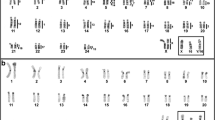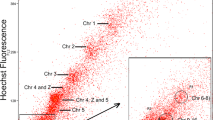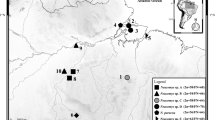Abstract
Cytogenetic studies have shown that New World primates are karyologically diverse and highly derived. The genus Callicebus is the best example of this karyological diversity, with diploid numbers ranging from 2n=50 to 2n=16. We report on Callicebus lugens, which has the lowest diploid number (2n=16) yet found in the primate order and represents a striking example of extreme karyotypic shuffling. To better understand the genomic rearrangements that have resulted in this extremely low diploid number, we mapped chromosome homologies between C. lugens and humans by in situ hybridization. The total number of hybridization signals was 42, excluding the Y chromosome, with a total of 34 syntenic associations not found in humans. This species has one of the most derived karyotypes among the Platyrrhini. Fusion has been the predominant mode of karyological evolution, although fissions and inversions have also transformed the C. lugens karyotype. Remarkably in such a highly rearranged karyotype, the synteny of 11 human chromosomes (4, 5, 9, 12, 13, 14, 17, 18, 20, 21, and X) was maintained intact, even if most of these human-homologous gene clusters were translocated. Other human syntenies, such as homologues to human chromosomes 10 and 16, were highly fragmented. Comparisons of the C. lugens-human homology map with those of other New World primates have not yet helped establish a phylogenic arrangement between congeneric species or link Callicebus with any other genus.




Similar content being viewed by others
References
Barros RM, Nagamachi CY, Pieczarka JC, Rodrigues LR, Neusser M, de Oliveira EH, Wienberg J, Muniz JA, Rissino JD, Muller S (2003) Chromosomal studies in Callicebus donacophilus pallescens, with classic and molecular cytogenetic approaches: multicolour FISH using human and Saguinus oedipus painting probes. Chromosome Res 11:327–334
Bonvicino CR, Penna-Firme V, Nascimento FF, Lemos B, Stanyon R, Seuanez HN (2003) The lowest diploid number (2n=16) yet found in any primate: Callicebus lugens (Humboldt 1811). Folia Primatol (Basel) 74:141–149
Chu EHY, Bender MA (1962) Cytogenetics and evolution of primates. Ann NY Acad Sci 102:253–266
Consigliere S, Stanyon R, Koehler U, Agoramoorthy G, Wienberg J (1996) Chromosome painting defines genomic rearrangements between red howler monkey subspecies. Chromosome Res 4:264–270
Consigliere S, Stanyon R, Koehler U, Arnold N, Wienberg J (1998) In situ hybridization (FISH) maps chromosomal homologies between Alouatta belzebul (Platyrrhini, Cebidae) and other primates and reveals extensive interchromosomal rearrangements between howler monkey genomes. Am J Primatol 46:119–133
Dutrillaux B, Couturier J, Viegas-Pequignot E (1986) Evolution chromosomique des Platyrrhiniens. Mammalia 50:56–81
Ford SM (1986) Systematics of the New World monkeys. In: Swindler DR, Erwin J (eds) Systematics, evolution and anatomy. Liss, New York, pp 73–135
Garcia F, Ruiz-Herrera A, Egozcue J, Ponsa M, Garcia M (2002) Chromosomal homologies between Cebus and Ateles (primates) based on ZOO-FISH and G-banding comparisons. Am J Primatol 57:177–188
Hershkovitz P (1963) A systematic and zoogeographic account of the monkeys of the genus Callicebus (Cebidae) of the Amazonas and Orinoco River basins. Mammalia 27:1–80
Hershkovitz P (1988) Origin, speciation, dispersal of South American titi monkeys, genus Callicebus (family Cebidae, Platyrrhini. Proc Acad Sci Phil 140:240–272
Hershkovitz P (1990) Titis, New World monkeys of the genus Callicebus (Cebidae, Platyrrhini) a preliminary taxonomic review. Field Zool 55:1–109
Kay RF (1990) The phyletic relationships of extant and fossil Pitheciinae (Platyrrhini, Anthropoidea). J Hum Evol 4:448–456
Koiffmann CP, Saldanha PH (1981) The karyotype of Cacajao melanocephalus (Platyrrhini, Primates). Folia Primatol (Basel) 36:150–155
Morescalchi MA, Schempp W, Consigliere S, Bigoni F, Wienberg J, Stanyon R (1997) Mapping chromosomal homology between humans and the black-handed spider monkey by fluorescence in situ hybridization. Chromosome Res 5:527–536
Muller S, Stanyon R, O’Brien PC, Ferguson-Smith MA, Plesker R, Wienberg J (1999) Defining the ancestral karyotype of all primates by multidirectional chromosome painting between tree shrews, lemurs and humans. Chromosoma 108:393–400
Murphy WJ, Stanyon R, O’Brien SJ (2001) Evolution of mammalian genome organization inferred from comparative gene mapping. Genome Biol 2:0005.1–0005.8
Neusser M, Stanyon R, Bigoni F, Wienberg J, Muller S (2001) Molecular cytotaxonomy of New World monkeys (Platyrrhini)—comparative analysis of five species by multicolor chromosome painting gives evidence for a classification of Callimico goeldii within the family of Callitrichidae. Cytogenet Cell Genet 94:206–215
O’Brien SJ, Stanyon R (1999) Phylogenomics. Ancestral primate viewed. Nature 402:365–366
Oliveira EH de, Neusser M, Figueiredo WB, Nagamachi C, Pieczarka JC, Sbalqueiro IJ, Wienberg J, Muller S (2002) The phylogeny of howler monkeys (Alouatta, Platyrrhini): reconstruction by multicolor cross-species chromosome painting. Chromosome Res 10:669–683
Rodrigues LR, Barros RM, Pissinatti A, Pieczarka JC, Nagamachi CY (2001) Cytogenetic study of Callicebus hoffmannsii (Cebidae, Primates) and comparison with C. m. moloch. Cytobios 105:137–145
Roosmalen MGM van, van Roosmalen T, Mittermeier RA (2002) A taxonomic review of the titi monkeys, genus Callicebus (Thomas 1903), with the description of two new species, Callicebus bernhardi and Callicebus stephennashi, from Brazilian Amazonia. Neotrop Primates 10 [Suppl]:1–52
Rosenberger AL, Coimbra-Filho AF (1984) Morphology, taxonomic status and affinities of the lion tamarins, Leontopithecus (Callitrichinae, Cebidae). Folia Primatol 42:149–179
Rosenberger AL, Setoguchi T, Shigehara N (1990) The fossil record of callitrichine primates. J Hum Evol 19:209–223
Schneider H, Canavez FC, Sampaio I, Moreira MA, Tagliaro CH, Seuanez HN (2001) Can molecular data place each neotropical monkey in its own branch? Chromosoma 109:515–523
Seuanez HN, Lima CR, Lemos B, Bonvicino CR, Moreira MA, Canavez FC (2001) Gene assignment in Ateles paniscus chamek (Platyrrhini, Primates). Allocation of 18 markers of human syntenic groups 1, 2, 7, 14, 15, 17 and 22. Chromosome Res 9:631–639
Stanyon R, Consigliere S, Muller S, Morescalchi A, Neusser M, Wienberg J (2000) Fluorescence in situ hybridization (FISH) maps chromosomal homologies between the dusky titi and squirrel monkey. Am J Primatol 50:95–107
Telenius H, Pelmear AH, Tunnacliffe A, Carter NP, Behmel A, Ferguson-Smith MA, Nordenskjold M, Pfragner R, Ponder BA (1992) Cytogenetic analysis by chromosome painting using DOP-PCR amplified flow-sorted chromosomes. Genes Chromosomes Cancer 4:257–263
Acknowledgement
Work was supported by Instituto Nacional de Câncer, Fundação Ary Frauzino and PRONEX (Brazil).
Author information
Authors and Affiliations
Corresponding author
Additional information
Communicated by S. Henikoff
Rights and permissions
About this article
Cite this article
Stanyon, R., Bonvicino, C.R., Svartman, M. et al. Chromosome painting in Callicebus lugens, the species with the lowest diploid number (2n=16) known in primates. Chromosoma 112, 201–206 (2003). https://doi.org/10.1007/s00412-003-0261-5
Received:
Revised:
Accepted:
Published:
Issue Date:
DOI: https://doi.org/10.1007/s00412-003-0261-5




